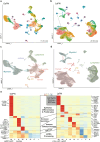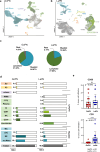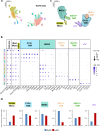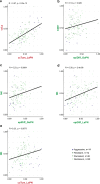Single-cell transcriptomics link gene expression signatures to clinicopathological features of gonadotroph and lactotroph PitNET
- PMID: 39548496
- PMCID: PMC11566263
- DOI: 10.1186/s12967-024-05821-4
Single-cell transcriptomics link gene expression signatures to clinicopathological features of gonadotroph and lactotroph PitNET
Abstract
Background: Pituitary neuroendocrine tumors (PitNET) are among the most common intracranial tumors. Despite a frequent benign course, aggressive behavior can occur. Tumor behavior is known to be under the influence of the tumor microenvironment (TME). However, the relationship between TME cells and aggressive tumor behavior has not been adequately explored in PitNET.
Methods: We performed differential expression analysis as well as gene expression program identification based on single-cell RNA sequencing to comparatively characterize the transcriptome of seven gonadotroph and three lactotroph PitNET and correlate it with clinical features using bulk RNA-seq data from an independent cohort of 134 PitNET. Tumor immune infiltration was quantified via immunostaining on tissue sections of gonadotroph and lactotroph PitNET.
Results: In lactotroph PitNET, we detect a highly proliferative gene profile with significantly increased expression levels in aggressively growing tumors within bulk RNA-seq data of an independent cohort of 134 PitNET samples. We also report high intratumoral heterogeneity in gonadotroph PitNET (GoPN) and lactotroph PitNET (LaPN) and identify signatures of epithelial, endocrine, and immunological gene networks in both subtypes. A comparison of their TME composition shows enrichment of SPP1+ macrophages and CD4+ T cells in GoPN, as well as enrichment of CD4/CD8 double-negative T cells (DN) and natural killer cells (NK) in LaPN. Also notable is the presence of proliferative lymphocytes, the occurrence of which positively correlates with more aggressive tumor behavior in the bulk RNA-seq cohort. However, increased CD8+ T and NK cell abundances correlate significantly with reduced aggressiveness indicating potential anti-tumoral effects.
Conclusions: Our study expands the knowledge of the differences in cellular composition of gonadotroph and lactotroph PitNET subtypes. It lays the foundation for further studies on the influence of lymphoid cells on the variable aggressive behavior of PitNET. Regarding the treatment of drug-resistant lactotroph PitNET, proliferative lymphocytes, CD8+ T, and NK cells could represent potentially valuable targets for developing new cancer immunotherapies.
Keywords: Gonadotroph; Intratumoral heterogeneity; Lactotroph; Pituitary neuroendocrine tumor (PitNET); Single-cell RNA sequencing; Tumor microenvironment.
© 2024. The Author(s).
Conflict of interest statement
Figures






References
-
- Karimian-Jazi K. Hypophysentumoren (pituitary gland tumors). Radiologe. 2019;59:982–91. 10.1007/s00117-019-0570-1. - PubMed
-
- Asa SL, Mete O, Perry A, et al. Overview of the 2022 WHO classification of pituitary tumors. Endocr Pathol. 2022;33:6–26. 10.1007/s12022-022-09703-7. - PubMed
-
- Vroonen L, Daly AF, Beckers A. Epidemiology and management challenges in prolactinomas. Neuroendocrinology. 2019;109:20–7. 10.1159/000497746. - PubMed
MeSH terms
Grants and funding
LinkOut - more resources
Full Text Sources
Medical
Molecular Biology Databases
Research Materials
Miscellaneous

